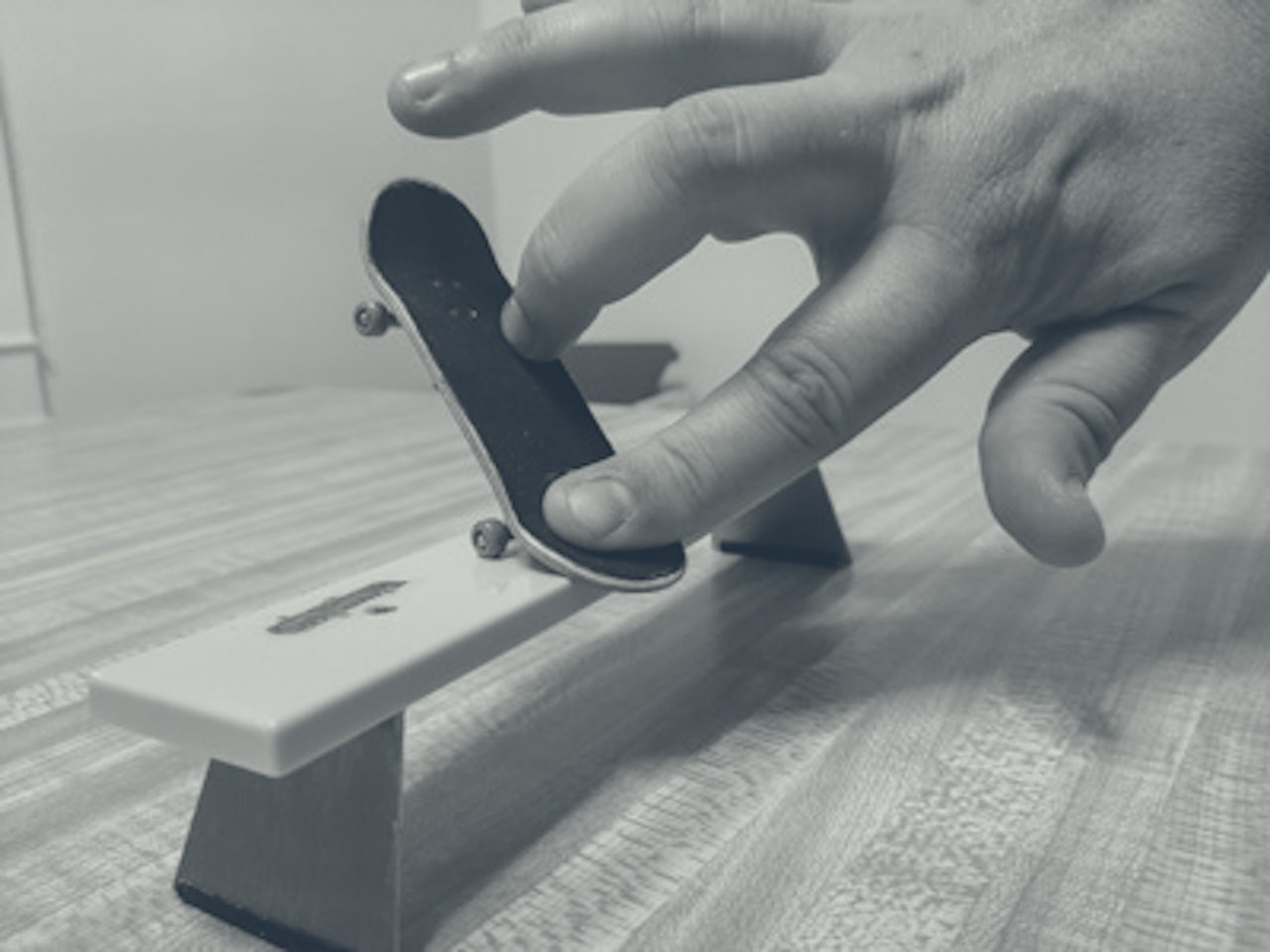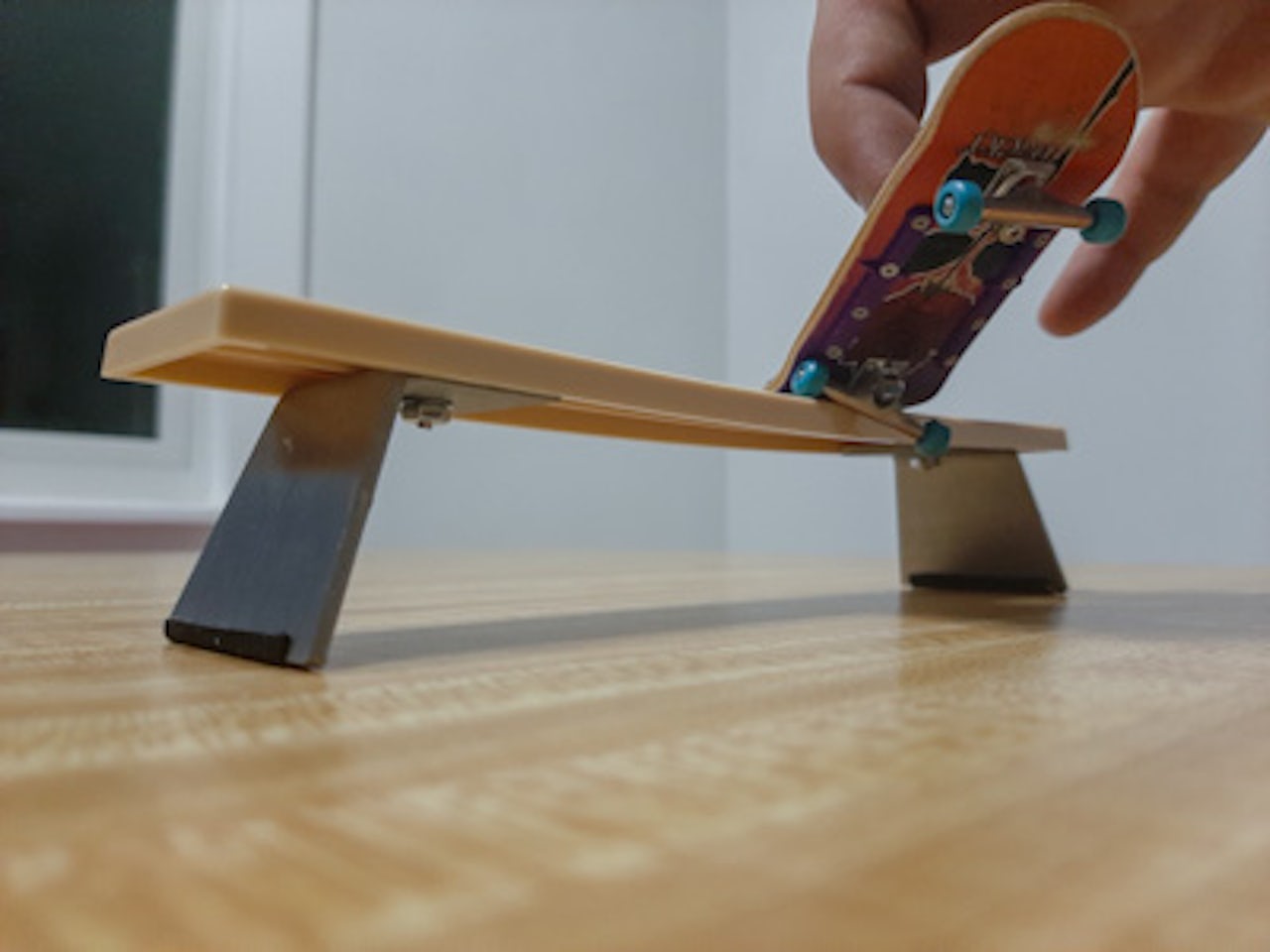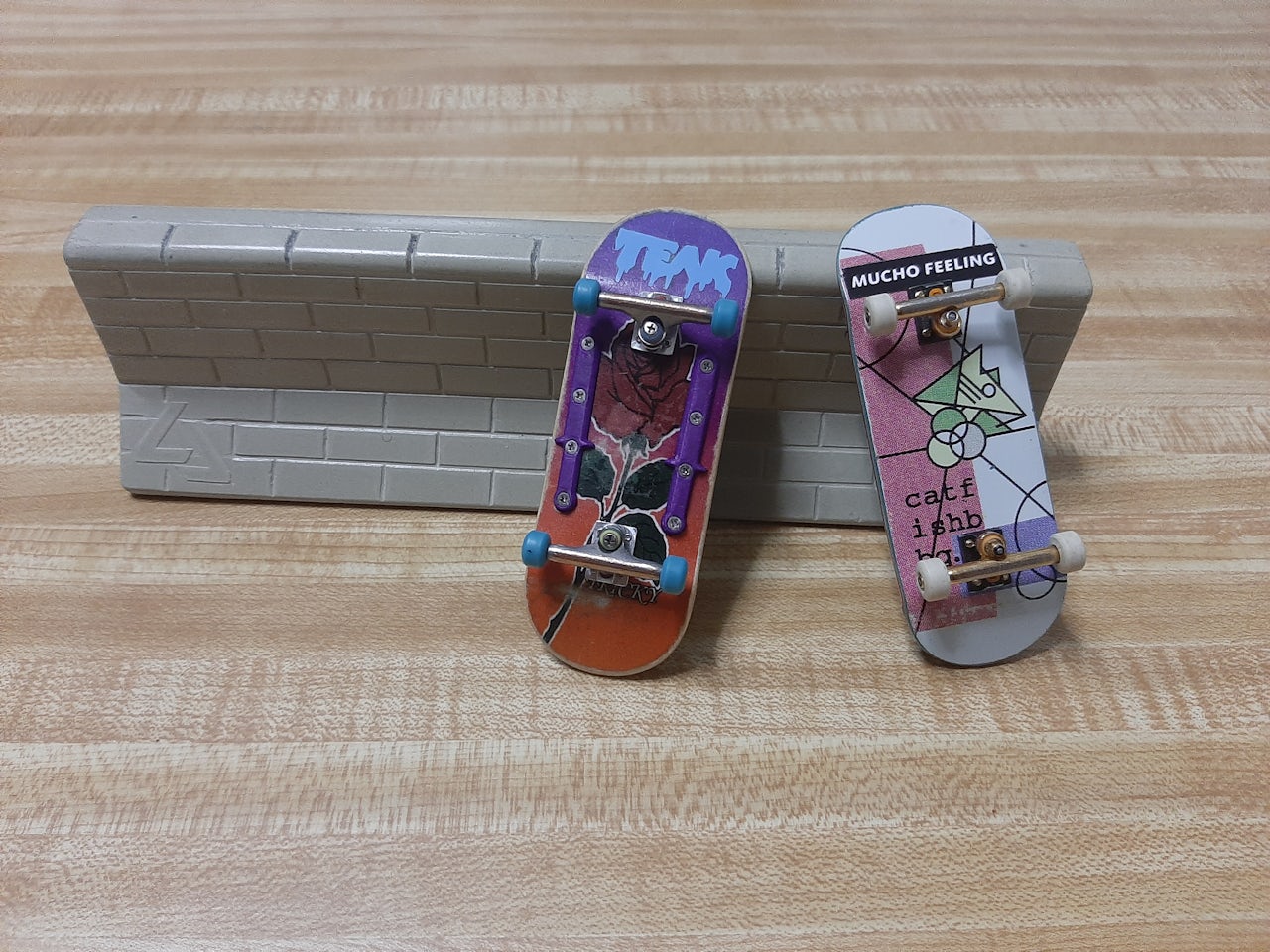I grew up in San Diego, a major hub for skateboarding in the 1990s. Kids at my middle school spoke of local pros like Peter Smolik and Jamie Thomas in reverent tones. At the skate shop near my house, Sun Diego, now-iconic videos like Toy Machine’s Welcome to Hell and the Shorty’s team showcase Fulfill the Dream played in mesmerizing loops on a small TV behind the counter.
Sadly, I wasn’t a very good skater myself. I hated falling over and getting hurt, which is one of the main prerequisites for skating. But I loved skateboarding — the aesthetic that came with it, the music playing in the background of skate videos, and the general outlaw vibe that a wooden board could confer upon whoever was associated with it — and I wanted to be involved with it in some capacity. And so, I was an early adopter of the fingerboard, miniature skateboard toys that became massively popular right when skate culture was entering the mainstream.
At Sun Diego, I would buy chunky, plastic, skateboard-shaped keychains, ripping the keyrings off and slapping on a miniature strip of grip tape to bust ollies off park benches, smashing to the ground and rolling away like a tiny pro. In 1998, I was strolling through the aisles of the California sporting goods store Sport Chalet when I spotted one of the first Tech Decks, a brand new style of fingerboard designed to look and feel like the real thing.
Tech Decks ended up becoming one of the beloved totems of my childhood. My friends and I collected them, sneaking in trick sessions in between classes at school. Sometimes I would stick my hand out of the car window, riding the wind and pretending to do tricks, like an ex-smoker wishing they had a cigarette between their digits. Even as an adult, I could still pop an ollie on a Tech Deck with confidence.
As I got older, fingerboarding was mostly a personal pursuit. I wasn’t seeking out fellow fingerboarders, or going to fingerboard events. It was just a little fun for old time’s sake.
But little did I know, the fingerboard craze that first took hold when I was a kid has evolved over the past 20 years into a highly specialized subculture all its own. Fingerboarding these days is painstakingly modeled on skateboarding, but also completely independent from it, unfolding in small gatherings across the globe, flourishing in hidden corners of social media and online retail. It’s a sport that’s not really a sport, pursued by people playing with a toy that’s not really a toy.
Fingerboards have been around since the late ’70s; pro skater Lance Mountain famously rides one that he fashioned himself in the 1985 Powell Peralta video, Future Primitive. But Tech Decks, created in the late ’90s by toy distributors Peter Asher and Tom Davidson (with help from pro skater Chet Thomas as well as Asher’s middle-school-aged son), changed the fingerboarding game. The original had removable plastic wheels, screwed-on metal trucks (the hardware used to fasten wheels to the deck), and licensed graphics from the most popular board makers of the day. Kids loved them: According to one estimate, sales of Tech Decks and other fingerboard products hit $120 million in 1999, the year after Tech Decks first hit store shelves.
Some veterans of the skateboarding industry welcomed the new trend, seeing it as a way to bring in more customers like me to the sport. “The idea is that a small kid would see this little skateboard — and they are cool little things — they’d see our graphics, and then be inspired to go get our skateboards,” Tod Swank, founder of the San Diego-based skateboard distribution company Tum Yeto, told a writer for Transworld Skateboarding in 2000. “It’s the brands we’re trying to get out there.”
Other skaters looked askance at the way Tech Decks opened the door for potential opportunists, eager to exploit skateboarding culture for their purposes. Oddly, though, nobody seemed to ask what the fingerboarders were thinking.
It would’ve been fair to assume that no real-deal fingerboarders actually existed back in ’99. But looking back, it seems there was a genuine scene taking off right from the start. Within months of Tech Decks landing on store shelves, the popular skate video series 411 Video Magazine put together Fingers of Fury!, a 15-minute video highlighting a group of finger-skaters from Canada and France, who somehow managed to master a number of insanely complex fingerboard tricks using their own collections of ledges, rails, and duct-taped quarter pipes.
The Marxist theorist Fredric Jameson predicted the arrival of consumerist phenomena like this in his 1991 book, Postmodernism, or The Cultural Logic of Late Capitalism. Exploring the differences between modernism and postmodernism in the realms of art, music, and architecture, Jameson argued that aesthetic value and commercial production became intertwined amid the rise of American power and the emergence of the global economy. In the rush to produce more and more stuff for ever-growing markets across the world, creative expression became a tool for creating value where there was none before:
What has happened is that aesthetic production today has become integrated into commodity production generally: the frantic economic urgency of producing fresh waves of ever more novel-seeming goods (from clothing to aeroplanes), at ever greater rates of turnover, now assigns an increasingly essential structural function and position to aesthetic innovation and experimentation.
If there was ever a perfect merger between “aesthetic production” and “commodity production,” these tiny, handmade skateboards were it.
Nowadays, on YouTube, Instagram and Reddit, fingerboarders from around the globe post videos of themselves performing imaginative tricks. In Houston, one guy’s rolling around in finger-jeans and finger-sneakers to the sound of the Virginia hip-hop duo Clipse. In Matosinhos, Portugal, another guy pops a perfect kickflip to feeble grind on a metal rail in an outdoor finger-skate park. The best finger-skaters show off their skills but also their style, shredding to soundtracks of indie music and underground hip-hop, just like in the classic skate videos from the 1990s. In Dracut, MA, the influential manufacturer and distributor Flatface Fingerboards has a public fingerboard park and hosts what it claims is the “biggest public fingerboard event in the USA.”
I stumbled across this fingerboard underworld last summer, after I moved from San Diego to Salt Lake City, Utah, to take my first full-time job in six years. I had no car and barely any friends. Any time I’d go for a stroll around the neighborhood, a fiery spike of pain would shoot through my left heel due to a case of plantar fasciitis. Suddenly, after years of waning interest, I became obsessed with fingerboards — they seemed like something I could actually get a handle on, in the face of more insurmountable burdens.
I became a fan of YouTube fingerboard personalities Kelsey Barker and Jeremy “ChubyMuffin” Pastor, and I kept finding references to something called “BRTs,” which I soon discovered was shorthand for a product called Blackriver Trucks. These tiny, immensely popular trucks are made by a company called Blackriver, based out of a small town in the German state of Bavaria. They cost $65 for a pair, more expensive than actual skateboard trucks (the company also makes fingerboard decks, wheels, grip tape, and “obstacles” to do tricks on). In pictures online, they glisten in colors of black, chrome, and gold. Many fingerboarders seem mystified by these coveted pieces of hardware. Reddit is full of posts asking if they’re worth the price compared to other types of fingerboard trucks; generally, the consensus seems to be yes.
Skateboarding has always been a mix of self-expression, marketing savvy, and shameless consumerism — and that’s the same in fingerboarding. On retail sites like Big Cartel and in the back alleys of Instagram DMs, fingerboard craftsmen like Vlad Ivanenko of Catfishbbq, John Cowart of Cowply, and Kalye Decks owners Christian Gonzales and Jude Lugtu sell handmade, five-ply wooden decks built to exacting specifications. Usually they feature original artwork applied to the board using heat-transfer techniques that allow for signs of skateboarding-style wear and tear. Other premiere brands like Joycult and Oak Wheels offer up urethane wheels with tiny bearings in them, while Blackriver, Dynamic Fingerboards, and Yellowood sell high-precision trucks that allow you to swerve and turn. At this point, the Tech Decks that birthed the trend are truly passé.
Sitting at my computer, my pulse quickened at the thought of putting in an order for a proper, custom fingerboard setup. I shopped around and settled on some black-and-gold BRTs; a green, Philippines-inspired “Tribal Mask” deck from Kalye Decks; and chalky white Oak wheels. Since I needed something to do tricks on, I also picked out a Blackriver “pocket kicker” ramp. The grand total came to $169.50. When I finally got my packages in the mail, on a blazing summer day in August, the little black box holding my BRTs made clear what I was getting myself into: “This is not a toy,” read a warning label on the front.
After unwrapping all the packaging, I sat at the Formica table in my kitchen and went about assembling my nifty new board. I peeled the paper from the adhesive backing of a strip of foam grip tape, and applied it carefully to the beautifully-made Kalye deck. Using a tiny yellow skate tool, I fastened the BRTs to the deck with eight, gold-colored screws that came with the trucks. Then I used the same tool to install the Oak wheels onto the BRTs’ axels, wrenching them in place with special “lock nuts,” designed to keep things from flying off while doing tricks. I’ve had past experience assembling skateboards and Tech Decks, so the entire process only took about half an hour.
Sitting at the kitchen table, I clicked and clacked around, wheels squeaking, trucks pivoting, trying to get my fingers into just the right position so that I could land a kickflip. I stuck out my tongue in concentration, and tried not to think about how weird this whole situation would look to an outsider — a 33-year-old man, cooped up alone in his apartment, learning a trick on a miniature skateboard. This became a daily ritual. After months of practice, I can now land pop shuvits, hardflips, kickflips, and 360 flips. I have rails and benches to do grinds, and a hulking Blackriver funbox that lets me hit big gaps and bust out tricky transition maneuvers.
Nowadays, as I trawl Instagram for posts about new fingerboard product drops, I get a jolt of excitement but also a queasy, guilty feeling over the way I buy in so readily to this underground world of creativity and commerce. Many of the hottest fingerboard makers tout the pristine quality and limited availability of their decks, ramps and griptape. I know this is partly a marketing ploy — a tactic to build up hype and drive sales — and I feel like I should resist, so as to spend my money on more “adult” things. But then there’s a trigger going off in my reptile brain, making me want this stuff so much more just because it’s rare and special.
There’s also something truly satisfying about having a tiny skateboard rolling beneath my fingers. Other veteran fingerboarders can relate. “It feels awesome to do the tricks,” Martin Ehrenberger, the founder of Blackriver, told me over Skype from his home in rural Bavaria, a short drive from the facility where he and a small team assemble BRTs, Blackriver ramps, and Berlinwood decks by hand.
Ehrenberger, 45, got his first Tech Deck back in 1998, at a skate shop in Salt Lake City during a snowboarding trip to Utah. “I’m still hyped, 22 years later,” he said. “For me, it’s a tool to get deeper into skateboarding.” When he isn’t skating, he’s doing hundreds of kickflips a day on a prototype fingerboard deck made of bamboo. He likens the practice to playing a guitar, giving him an outlet for boundless expression. “Skating has so much to do with emotions and feelings, more than making the best tricks or being the best. I see the same with fingerboards,” he said.
There isn’t much of a fingerboarding scene in Salt Lake City these days, but recently I sent a DM over Instagram to a fellow local fingerboarder who goes by the username fingaflippa. He wrote back to me almost immediately, and we scheduled a finger-skate sesh at his house for the next day.
Fingaflippa’s real name is Chase Jackson. He’s 29, and when I came over after work, his kitchen countertops were covered in obstacles, rails and ramps of all kinds — fingerboard heaven. His path into this unlikely hobby was a lot like mine, germinating years ago and then blossoming in adulthood as a latent obsession. “It’s been about a year that I’ve been into it. I’ve liked it since the Tech Deck days, but I never knew people got serious,” he told me. “Fingerboarding was just like skating. But I never got good at skating, so it was like, ‘Hey, no injury!’”
Two hours passed by in a blink as we skated the granite countertops. Chase busted a varial flip to a 50-50 grind, shredding across a Blackriver ledge made of real brick. I clacked my board off the edge of a five-stair rail and landed a perfect 360 flip.
At one point I felt that familiar, queasy pang of guilt again. Shouldn’t I be ashamed for indulging in something this small? But it was alright. Everything was chill. As we kept skating, my internal struggle mellowed. No matter what, I realized, I would always be a fingerboarder.



